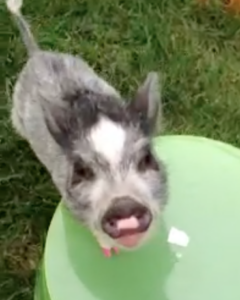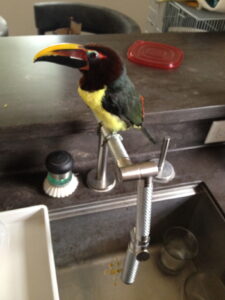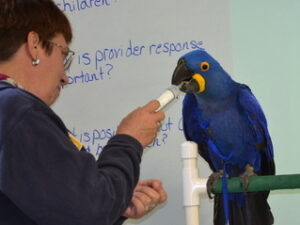Barks Blog
Target Practice
By Lara Joseph

Training animals to target makes husbandry a lot less stressful and much safer. It is also a useful tool to have at your disposal in an emergency situation. But first, let’s define some of the terms:
Targeting is getting an animal (or human) to touch a predetermined body part to a particular object.
Stationing is teaching the animal (or human) to continue targeting until cued to do otherwise.
Targeting is such a common behavior that many people train it without realizing. When we attend an event and are asked to go to our seats, the instructor is targeting our behinds to a chair. When we stay in our seats until being told it is time for a break, we have stationed until being cued otherwise. There are so many instances where targeting and stationing are beneficial to our animals that we should be training these behaviors consciously. Doing so will make their lives less stressful by giving them an attractive choice of what to do and how to behave in countless situations.
Working in a multi-animal and species facility, I find that training an animal to touch his beak, snout or nose to the end of a target stick is an excellent way to keep control of a group when they are all outside together. Once trained to target, I can use the target stick to get the animals to walk, fly or swim to areas I need or want them to be. It is also an ideal way to implement force-free training to help them make the right choice and move to a station when cued before a potential accident can happen. The practice and training helps keep the animals poised to reliably make the safe choice when an emergency recall, target or station is cued.
An emergency recall, target or station comes in very handy because we never plan an accident. I train the mammals to target and station to either the tops of buckets or to carpet squares. I need at least all feet on the target. The birds target and station to perches or banisters placed intentionally high up off of the ground where the mammals cannot jump or leap and people cannot reach. This arrangement is also very useful even when an emergency is not in place. Getting the animals to target and station helps me retain focus and control. For increased complexity in training, I will call one animal to me while the others remain stationed. This helps me train impulse control and focus in an environment full of distractions.

Teaching an animal to target and station is also a good way to keep an eye on animals who are notorious for getting into things you do not want them to. It is also useful if you are working on potty training. I taught a green aracari (toucanette) to target her feet to the faucet and station there until cued to do otherwise. She was infamous for flying to the cages of other birds and biting through cage bars. I did not want to restrict her to life in a cage so this was one of many things we taught her to do in order for her to be out safely with other birds.
When we sweep trash or daily debris into a pile, most of our animals find watching us do this a form of enrichment. It is always a bonus to find a new form of enrichment but when we need to clean, we need to clean. So instead of telling the animals what not to do, we cue them to target and station on carpet squares and reinforce that behavior. At the same time we keep journals noting what different animals regard as enrichment.
Many husbandry behaviors require targeting and stationing. We have so many animals at the Animal Behavior Center, where I am based, it seems like we are constantly and consistently training for husbandry behaviors such as nail trims, syringe training, temperature taking, hoof trimming, ear inspections, scale training, wing inspections etc. As we all know, the sight of a syringe can be a strong cue for an animal to run or fly from you at lightning speed. Also, as we all know, this is learned behavior. We can, of course, learn a lot about an animal’s history of reinforcement from his behavior.

From my experience, it can take longer to counter condition a prey animal than other animals. For the bird being trained to accept a syringe (see photo), counter conditioning would not have been necessary had he been handled properly in the first place. Then again, if this were a perfect world, most of us in the behavior modification field would not have much of a case load.
One area where I am often asked to help in the world of prey animals is to counter condition some of the behaviors they exhibit in response to husbandry. I really enjoy showing people there is no need to chase a bird with a towel to do nail trims, get samples for gram stains or administer medications. I always encourage people to leave their birds flighted while teaching them the desired behaviors of taking medications, accepting restraint and flying to the veterinarian’s hand.
Although stationing can really help to make mealtimes stress free, I never feed prey and predator together without either a barrier or consistent supervision until training is completely reliable.
In this video I am training Milo, our teaching pig, to station between the wall and the dog crate with the dogs on the other side of the gate. I am training this because I need to make sure Milo leaves the dogs alone while I feed them on the other side of the gate, as opposed to trying to charge at their food dishes. At first I toss the reinforcer to the area I want Milo to station to. Then I train him to go to his station on a verbal cue. A bridge is a conditioned reinforcer that is able to reinforce the desired behavior the moment it happens. My bridge is the word “Good” and you can see him clearly respond to it. You will see him quickly learn to back up into the area where I want him to station. This is a very helpful behavior to train.
Reference
The Animal Behavior Center. (2014, December 10). Station for Purpose and Function. Available at: https://www.youtube.com/watch?v=1nSUl4MiM_s&feature=youtu.bwww.youtube.com/watch?v
=gBmsgfKB5wEe
This article first appeared in BARKS from the Guild, March 2015, pp.32-33. For more great content on all things animal behavior and training, you can sign up for a lifetime, free of charge, subscription to the digital edition of BARKS from the Guild. If you are already a subscriber, you can view the issue here.
About the Author
Lara Joseph is the owner of The Animal Behavior Center, an international, educational center in Sylvania, Ohio focusing on teaching people how to live, love, and work with animals using positive reinforcement and approaches in Applied Behavior Analysis. She is a professional animal behavior consultant and trainer with a focus on exotics and travels internationally giving workshops, lectures, and provides online, live-streaming learning programs on behavior, training, and enrichment. Her focus is on behavior and training with all species of animals whether in the home, shelter, zoo, or educational ambassador. She sits on the advisory board for All Species Consulting, The Indonesian Parrot Project, Collaboration for Avian Welfare, and is the director of animal training for Nature’s Nursery, a wildlife rehabilitation center in Whitehouse, Ohio. She is also the founder of several animal organizations for animal welfare and has much experience working with special needs animals. She is a published author and writes regularly for several periodicals and also blogs for Deaf Dogs Rock. She has also been asked to co-author and is currently working on an international manual of animal behavior and training. She is a guest lecturer in Zoo Biology; Animal Nutrition, Behavior and Diagnostics taught by Dr. Jason Crean at St. Xavier University in Chicago, Illinois.

